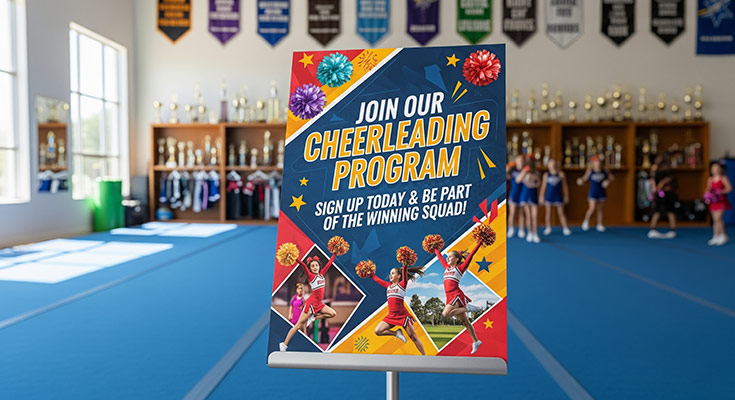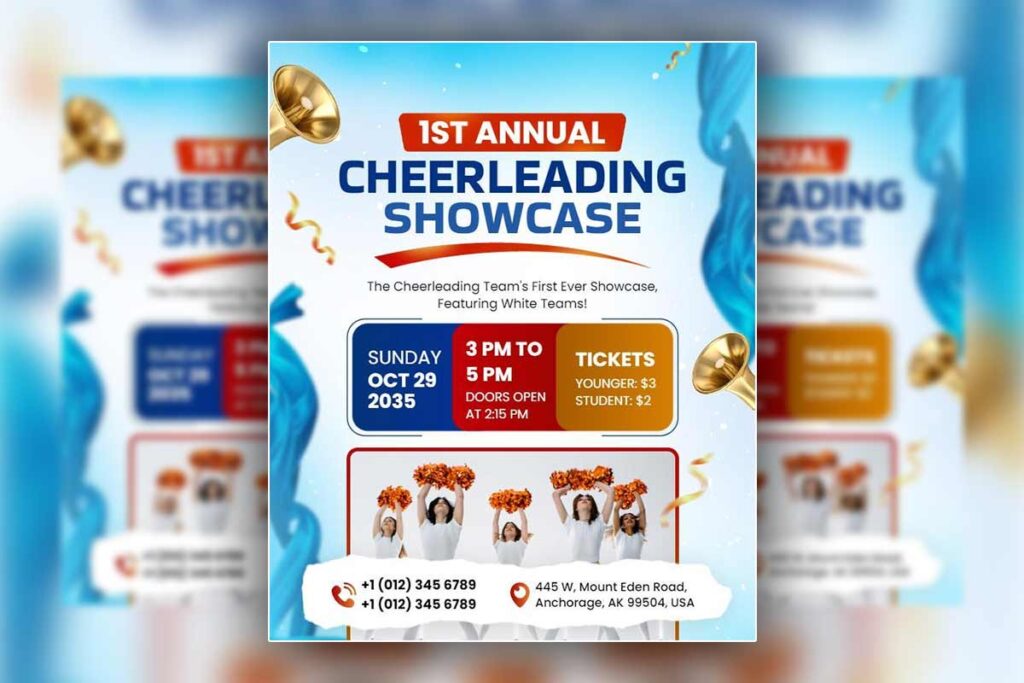Most flyer creation attempts fail because program directors overlook fundamental design principles that separate amateur from professional results. Effective cheerleading flyer design combines strategic visual storytelling with proven marketing materials that instantly communicate coaching expertise and student outcomes to prospective families.
Professional flyer creation requires systematic integration of cheerleading flyer templates, achievement showcases, and credibility markers that drive enrollment decisions. Quality implementation using editable flyer templates demands understanding how visual hierarchies, typography choices, and color psychology work together to differentiate your program from competitors while maintaining trustworthy authority.
This specialist guide covers comprehensive cheerleading team flyer creation methodologies that deliver measurable recruitment results. You’ll discover strategic cheerleading recruitment flyers techniques, professional design elements that showcase program excellence, and implementation systems that maximize visibility during peak enrollment periods. Transform generic promotional materials into powerful conversion tools that attract premium families seeking proven coaching effectiveness and demonstrated student success.
How Can Cheerleading Flyer Design Showcase Your Program’s Coaching Effectiveness To Potential Families?
Effective cheerleading flyer design demonstrates coaching expertise through strategic visual storytelling that highlights measurable program outcomes. Professional layouts featuring before-and-after skill progressions, coach certifications, and structured training methodologies instantly communicate competence to discerning families, especially when using proven cheerleading lead generation strategies for private coaches. Strategic placement of competition rankings, safety records, and athlete testimonials creates credibility markers that distinguish superior programs from competitors. Visual hierarchies emphasizing coaching philosophy, training systems, and proven development pathways help families understand your program’s systematic approach to athlete growth, making coaching effectiveness tangible through purposeful design elements.
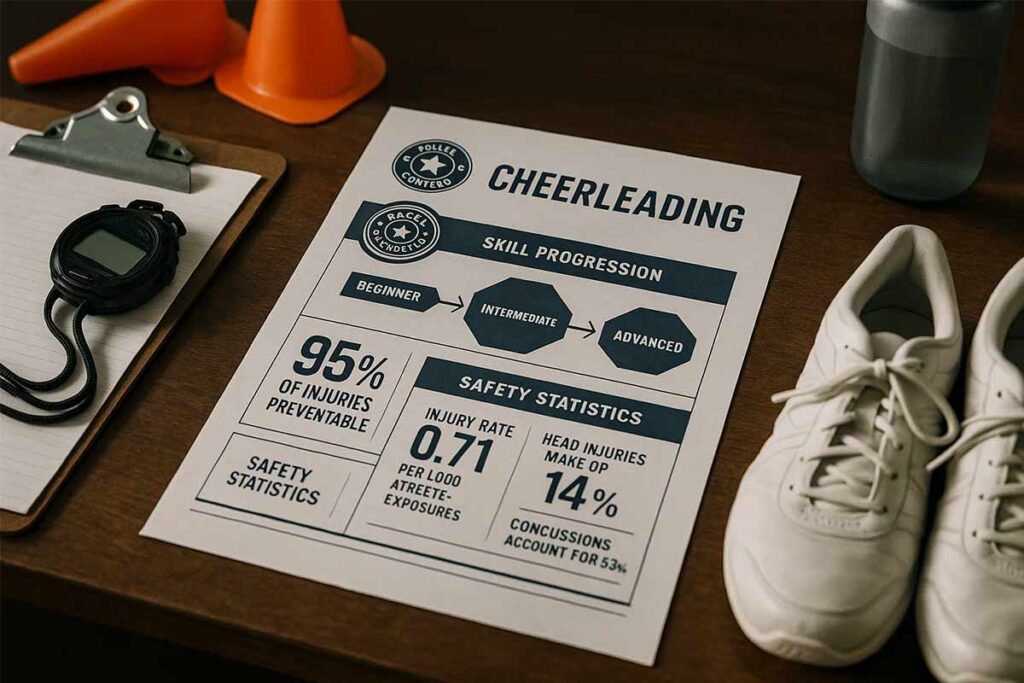
Visual Documentation of Coaching Credentials and Training Methodologies
Cheerleading flyer templates should prominently display coaching certifications, safety training credentials, and years of experience through dedicated credential sections. Create visual badges showcasing USASF certifications, First Aid/CPR qualifications, and continuing education achievements. Include coach biography sections highlighting competitive backgrounds, training philosophies, and specialized skill development expertise. Professional headshots paired with qualification summaries build immediate trust with safety-conscious parents.
Visual methodology displays show families your systematic approach to skill development. Create infographic-style sections illustrating progressive training techniques, from fundamental skills to advanced stunting. Use clean typography and organized layouts to present coaching certifications as quality indicators. Professional design elements like certificate borders and achievement badges reinforce credibility while maintaining visual appeal.
Showcase your coaching expertise with DesignWiz’s specialized cheerleading templates featuring dedicated credential sections and professional certification badge layouts.
- Kids Cheerleading Camp Workshop Flyer Template
- Vibrant Pink Mini Cheerleader Camp Registration Flyer Template
- Youth Cheerleading Camp Promotional Flyer Template
Strategic Placement of Safety Records and Competition Performance Metrics
Safety statistics deserve prominent placement in cheerleading recruitment flyers, positioned prominently above fold. Display injury-free training hours, safety protocol adherence rates, and certified spotter ratios using clear numerical graphics. Research shows that proper safety protocols and qualified coaching significantly reduce injury risks in cheerleading programs.1 Competition achievements require strategic visual weight through trophy graphics, placement rankings, and team accomplishment timelines. Create dedicated sections for recent wins, regional rankings, and championship appearances.
Performance metrics gain impact through visual comparison charts showing program growth over time. Include scholarship recipient statistics, college placement rates, and skill advancement percentages. Parents appreciate concrete data presented through clean infographics and achievement galleries. Safety records build trust while competition results demonstrate coaching effectiveness, requiring equal visual emphasis in professional cheerleading team flyer creation.
Before-and-After Skill Progression Showcases That Prove Development Systems
Skill progression documentation provides powerful visual proof of coaching effectiveness through transformation storytelling. Create athlete journey timelines showing individual development from tryout through championship performance levels. Use photo sequences demonstrating tumbling advancement, stunt progression, and dance technique refinement. Timeline layouts with milestone markers show systematic skill building over training seasons.
Video stills or action photography capturing skill execution at different proficiency levels create compelling visual narratives. Include testimonials from athletes and parents describing specific improvements achieved through your coaching methods. Research supports that systematic coaching approaches with documented progression tracking lead to better athlete development outcomes.2 Cheerleading camp flyer ideas and templates should feature these progression showcases prominently to demonstrate tangible results.
Group transformation stories showing team chemistry development, confidence building, and leadership growth appeal to families seeking holistic athlete development. Professional photography showcasing proper technique execution reinforces coaching quality while progression documentation proves systematic development approaches. Best cheerleading fundraiser flyer designs incorporate these proof points strategically to justify program investment and differentiate from competitors through measurable coaching outcomes.
What Cheerleading Flyer Design Elements Best Communicate Student Achievement Outcomes?
Student achievement communication requires specific design elements that transform abstract success into visual proof points for families evaluating programs. Award galleries with high-quality imagery, scholarship statistics prominently displayed, and college placement records create immediate credibility. Performance timeline graphics showing individual athlete journeys from beginner to elite levels demonstrate tangible progression pathways. Achievement badges, certification logos, and competition medal displays provide instant recognition of program success, while testimonial integration with photos creates authentic social proof that resonates with prospective families seeking proven results. Research demonstrates that effective visual communication significantly enhances information retention and decision-making processes for educational stakeholders.4
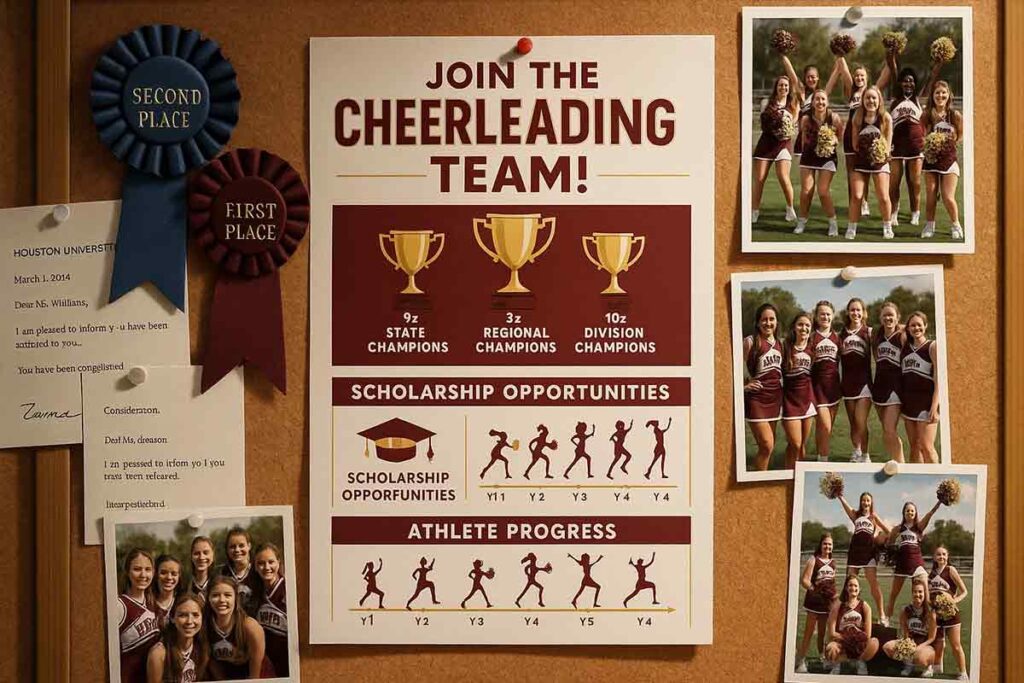
Award Gallery Layouts That Transform Achievements Into Visual Proof Points
Professional cheerleading flyer design showcases awards through strategic grid layouts featuring trophy photography, medal collections, and competition banners. High-impact visuals require consistent lighting and professional photography that makes achievements appear substantial and impressive. Award galleries work best when organized chronologically or by achievement level, creating visual narratives that demonstrate consistent success over time.
Effective layouts use varying image sizes to create visual hierarchy, positioning major championships prominently while supporting awards provide comprehensive success evidence. Color coordination between award elements and overall cheerleading flyer templates maintains brand consistency while achievement density communicates program excellence. Parents respond to quantified success displays showing specific competition placements, regional rankings, and championship victories that validate coaching effectiveness and justify program investment costs.
Create stunning award showcases with DesignWiz’s cheerleading flyer templates designed specifically for displaying trophies, medals, and competition achievements.
- Cheerleading Recognition Banquet Celebration Invitation Flyer Template
- Football and Cheerleading Banquet Celebration Invitation Flyer Template
- Annual Cheerleading Competition Event Flyer Template
Scholarship and College Placement Statistics Integration for Long-term Success Communication
Scholarship data presentation requires infographic-style elements that make financial achievements immediately comprehensible to parents evaluating long-term program value. Effective cheerleading team flyer creation incorporates scholarship dollar amounts, college logos, and placement percentages using professional data visualization techniques. Statistical displays work best when contrasted against industry averages, demonstrating superior program performance compared to competitors. NCAA data shows that Divisions I and II schools provide almost $4 billion in athletics scholarships annually to more than 196,000 student-athletes, highlighting the competitive nature of athletic scholarship opportunities.3
College placement sections should feature recognizable university logos arranged by prestige level, creating aspirational visual connections for prospective families. How to design cheerleading tryout flyers benefits from percentage displays showing college acceptance rates, scholarship recipient ratios, and academic achievement correlations. Integration of student photos with their destination colleges personalizes statistics while maintaining privacy standards appropriate for recruitment materials.
Highlight your program’s success with DesignWiz’s data-driven cheerleading templates featuring infographic elements for scholarship statistics and college placement records.
- Cheerleading Sponsorship Opportunity Flyer Template
- Cheerleading Tryouts Announcement Flyer Template
- Cheerleading Fundraiser Event Flyer Template
Performance Timeline Graphics Showing Individual Athlete Development Journeys
Timeline visualizations demonstrate systematic skill progression through before-and-after photography paired with skill milestone markers. Effective progression graphics use consistent athlete positioning and background elements that highlight technical improvements over training periods. Visual storytelling through timeline layouts proves coaching methodology effectiveness by showcasing measurable skill advancement from beginner through advanced competitive levels.
Individual journey graphics work best when featuring 3-5 milestone photographs showing clear skill evolution, accompanied by achievement badges marking specific accomplishments. Cheerleading flyer graphics and fonts should complement timeline elements without overwhelming photographic content that provides primary social proof. Professional photography standards maintain consistency across timeline elements while demographic diversity in featured athletes appeals to broader family audiences.
Timeline integration with award galleries and statistics creates comprehensive achievement narratives that address different parent priorities simultaneously. Cheerleading flyer design software enables template customization that maintains professional visual standards while accommodating varying achievement levels and program focus areas. Best cheerleading fundraiser flyer designs incorporate achievement elements strategically to justify program costs through demonstrated value delivery and proven student success outcomes.
How Do Professional Cheerleading Flyer Designs Help Differentiate Your Program From Competitors?
Professional cheerleading flyer design establishes immediate credibility through polished visual storytelling that showcases your program’s unique coaching methodology and student success rates. Strategic use of brand consistency, achievement highlights, and testimonial integration creates memorable first impressions that distinguish your services from generic competitors. Quality flyer templates demonstrate attention to detail and professionalism that parents associate with superior coaching standards. Effective cheerleading recruitment flyers position your program as the premium choice by visually communicating your competitive edge, safety protocols, and proven track record of developing championship-level athletes and confident performers.
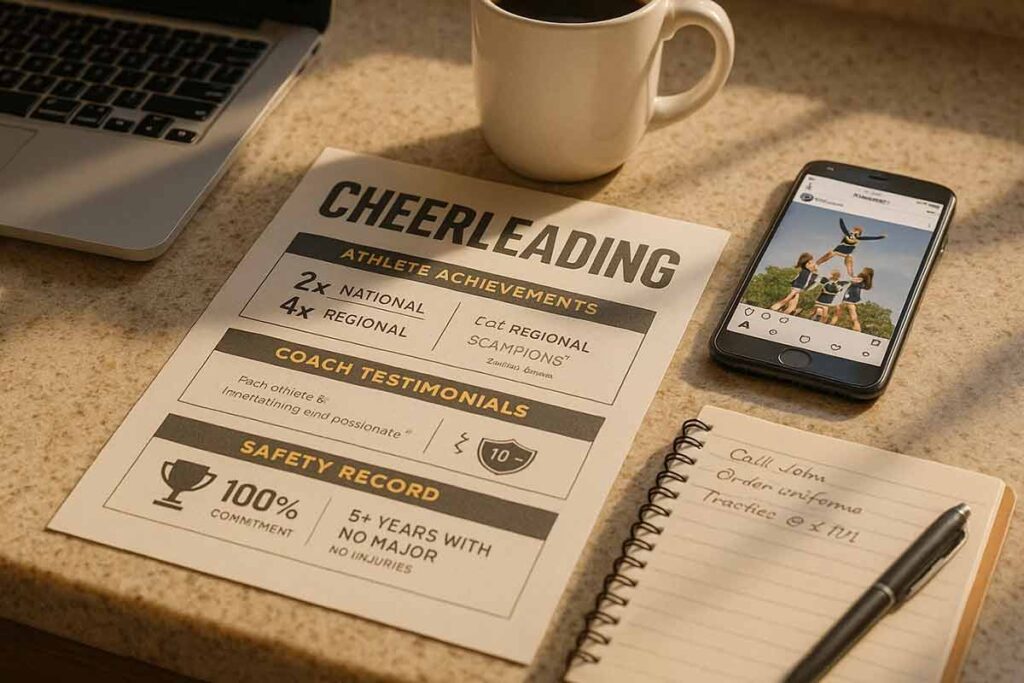
Brand Identity Consistency Across All Cheerleading Marketing Materials
Consistent visual branding across all cheerleading marketing materials creates instant recognition and professional credibility that sets premium programs apart. Professional logos, standardized color schemes, and uniform typography across flyers, banners, and digital materials demonstrate organizational sophistication that parents associate with quality coaching.
Strategic color psychology reinforces program values – deep blues convey trust and stability, while gold accents suggest excellence and achievement. Consistent placement of contact information, coach credentials, and safety certifications creates familiarity that builds parent confidence. Programs with cohesive branding appear more established and trustworthy compared to competitors using random design elements. Marketing research shows that consistency builds trust, making brand consistency a critical factor in establishing program credibility with prospective families.5
Font selections should reflect program personality while maintaining readability. Modern sans-serif fonts communicate contemporary coaching approaches, while traditional serif fonts suggest established expertise. Template consistency prevents the amateur appearance that immediately identifies lower-quality programs to discerning families evaluating options.
Maintain professional brand consistency with DesignWiz’s coordinated cheerleading template collection designed for cohesive program marketing across all materials.
- Annual Cheerleading Competition Event Flyer Template
- Ripe Lemon Sports Flyers Template
- Cheerleading Coach Recruitment Opportunity Flyer Template
Strategic Achievement Highlighting That Builds Coaching Credibility
Achievement showcases transform abstract coaching claims into visual proof points that justify premium program positioning. Strategic placement of competition wins, championship banners, and skill progression statistics provides immediate credibility differentiation from competitors lacking documented success.
Medal displays, scholarship recipient highlights, and college placement records create compelling narratives about program effectiveness. Visual timelines showing athlete development from beginner to elite levels demonstrate systematic coaching excellence that parents seek for their children.
Performance metrics including team GPA improvements, leadership development outcomes, and community service achievements appeal to families prioritizing holistic development beyond athletic performance. Safety statistics and injury prevention records address primary parent concerns while highlighting professional coaching standards.
Before-and-after skill progression photography provides tangible evidence of coaching effectiveness that generic marketing claims cannot match. These authentic success stories differentiate your program from competitors relying on stock imagery and unsupported promises.
Professional Visual Storytelling That Attracts Premium Families
Visual storytelling elevates cheerleading flyer design beyond basic information delivery to create emotional connections with prospective families. Professional photography showcasing proper technique demonstration, diverse skill levels, and supervised training environments builds trust while communicating safety-first coaching philosophies.
Action shots capturing team celebrations, individual achievement moments, and coach-athlete interactions create authentic program narratives that resonate with parents seeking positive developmental experiences. High-quality facility photography highlighting professional equipment and safe training spaces addresses primary family concerns about program standards.
Testimonial integration with authentic family photos creates powerful social proof that distinguishes established programs from newcomers. Parent quotes about coaching quality, communication excellence, and student development outcomes provide third-party validation that self-promotion cannot achieve.
Strategic layout hierarchy guides parent attention from compelling headlines about team success to specific outcomes like competition wins and skill development milestones. Professional typography and color contrast ensure information accessibility while maintaining visual appeal that commands attention in competitive recruitment environments.
Quality template design communicates organizational competence that parents associate with superior coaching standards, creating competitive advantage through visual excellence alone.
Which Cheerleading Flyer Design Layouts Most Effectively Highlight Team Accomplishments?
Timeline-based layouts featuring chronological achievement progression most effectively showcase team accomplishments by creating compelling success narratives. Grid-style cheerleading event flyers displaying trophy collections, competition placements, and skill advancement levels provide immediate visual impact for prospective families. Medal and banner showcase designs with prominent photography demonstrate tangible results while building program credibility. Infographic-style cheerleading team flyer creation incorporating statistics, win percentages, and skill progression data appeals to results-focused parents seeking measurable coaching outcomes. Layout selection depends on achievement type, with championship victories requiring different visual treatment than skill development milestones.
Championship Trophy Display Layouts for Maximum Visual Impact
Trophy showcase layouts maximize visual impact through strategic photography and organized display hierarchies. Professional cheerleading flyer design places largest trophies prominently in upper sections, with smaller awards creating supporting visual elements. Competition banners serve as powerful background elements that establish program credibility immediately. Medal collections arranged chronologically demonstrate sustained excellence over multiple seasons. Strategic use of metallic colors and high-contrast backgrounds makes awards appear more prestigious while maintaining readability.
Grid-style arrangements work effectively for programs with extensive trophy collections, allowing parents to quickly assess competitive success levels. Vertical trophy timelines create compelling success stories by showing progression from local to regional to national achievements. Each trophy should include competition name, placement, and date for credibility verification. Quality photography with proper lighting enhances trophy appearance and conveys professionalism that parents associate with superior coaching standards.
Transform your team’s achievements into compelling visual stories with DesignWiz’s championship-focused cheerleading flyer templates featuring optimal trophy layout designs.
- Cheerleading Recognition Banquet Celebration Invitation Flyer Template
- Annual Cheer Banquet Invitation Flyer Template
- Football and Cheerleading Banquet Celebration Invitation Flyer Template
Skill Progression Timeline Designs That Demonstrate Coaching Excellence
Timeline-based skill progression layouts demonstrate coaching effectiveness through visual before-and-after documentation. Monthly milestone markers show specific skill acquisitions, from basic jumps to advanced stunting techniques. Strategic use of progression photography captures athletes at different development stages, creating powerful visual narratives for prospective families. Color-coded skill categories help parents understand comprehensive training approaches.
Infographic elements transform abstract coaching concepts into measurable outcomes parents can evaluate. Percentage-based progress indicators show skill mastery rates across team members. Achievement badges mark specific accomplishment milestones like first successful back handspring or advanced tumbling passes. Video thumbnail integration allows digital versions to showcase actual skill demonstrations. Timeline designs should emphasize safety protocols and supervised progression to address parental concerns about injury risks while highlighting coaching competence.
Statistical Achievement Infographics for Data-Driven Parent Appeal
Data-driven infographics appeal to analytically-minded parents seeking quantifiable coaching results. Win-loss ratios, skill advancement percentages, and team GPA improvements provide concrete evidence of program effectiveness. Statistics comparing team performance to regional averages demonstrate competitive advantages while scholarship placement rates highlight long-term value propositions.
Bar charts showing competition score improvements over time create compelling visual stories of coaching excellence. Pie charts illustrating skill mastery distribution across team members demonstrate comprehensive training effectiveness. College recruitment statistics positioned prominently attract parents focused on athletic scholarship opportunities. Safety record data including injury-free training hours builds trust with risk-conscious families.
Comparative statistics showing team performance versus regional competitors establish credible benchmarks parents can evaluate. Revenue fundraising totals demonstrate program sustainability and community support levels. Individual athlete spotlights featuring personal achievement statistics create aspirational examples for prospective team members. Geographic competition reach maps show program prestige through regional and national participation levels.
Professional data visualization using consistent color schemes and readable fonts maintains credibility while avoiding overwhelming busy layouts that distract from key performance indicators.
What Color Schemes In Cheerleading Flyer Design Convey Expertise And Trustworthiness?
Professional cheerleading flyer design relies on strategic color psychology to establish credibility with parents and athletes. Deep navy blues paired with crisp whites communicate stability and competence, while burgundy and gold combinations suggest prestige and achievement. Sophisticated charcoal grays with accent colors demonstrate modern professionalism without appearing flashy. Avoid overly bright or neon combinations that can appear unprofessional. The key is creating visual hierarchy through contrast while maintaining consistency with your program’s established brand identity. These trusted color foundations allow achievement showcases and success metrics to take center stage in recruitment materials.
Navy Blue and White Combinations for Coaching Authority
Navy blue and white create immediate associations with authority, discipline, and professional competence. This classic combination mirrors academic institutions and established organizations, lending instant credibility to your cheerleading program marketing materials. The high contrast ensures readability across all formats while maintaining sophistication. Navy backgrounds with white text highlight crucial information like safety certifications and coaching credentials effectively.
Use navy blue for header sections containing program names and contact information, while white spaces showcase student testimonials and achievement galleries. This palette works exceptionally well for cheerleading recruitment flyers targeting serious athletes and achievement-focused families. The combination suggests systematic training approaches and proven methodologies that discerning parents associate with quality coaching programs. Accent colors in gold or silver can highlight specific accomplishments without compromising the authoritative foundation.
Establish coaching authority with DesignWiz’s professional cheerleading templates featuring navy and white color schemes that communicate competence and reliability.
- Cheerleading Fundraiser Event Flyer Template
- Cheerleading Sponsorship Opportunity Flyer Template
- Cheerleading Banquet Invitation Flyer Template
Burgundy and Gold Palettes That Signal Program Excellence
Burgundy and gold combinations evoke prestige, tradition, and championship-level achievement. These colors mirror elite athletic programs and academic institutions, immediately positioning your cheerleading team among premium offerings. The rich burgundy provides excellent contrast for white text while gold accents highlight awards, statistics, and premium program features.
This palette proves particularly effective for programs emphasizing competitive excellence and college placement success. Use burgundy backgrounds for sections showcasing team accomplishments and coaching credentials, while gold callouts emphasize scholarship recipients and competition victories. The combination appeals to families seeking high-performance training environments and proven track records. These colors photograph beautifully in both print and digital formats, maintaining impact across all cheerleading flyer marketing materials and promotional designs.
Modern Charcoal Gray Schemes for Contemporary Professionalism
Charcoal gray schemes offer sophisticated alternatives to traditional color combinations while maintaining professional credibility. These contemporary palettes appeal to modern families seeking progressive coaching approaches combined with proven results. Gray foundations provide versatility for incorporating team colors as strategic accents without overwhelming the design.
Use varying gray tones to create depth and visual interest while maintaining clean, readable layouts. Lighter grays work well for background sections, while darker charcoal highlights important information and creates strong contrast with white text. Strategic color accents in your team’s signature colors add personality without sacrificing professionalism.
This approach works exceptionally well for cheerleading team flyer creation targeting tech-savvy families and urban markets. The modern aesthetic suggests innovation and forward-thinking coaching methodologies while remaining timeless enough for long-term brand consistency. Gray schemes photograph consistently across different lighting conditions, ensuring your marketing materials maintain professional appearance whether displayed digitally or in print format.
How Can Cheerleading Flyer Design Templates Be Customized To Reflect Your Coaching Philosophy?
Customizing cheerleading flyer design templates to reflect coaching philosophy requires strategic alignment between visual elements and core values. Coaches emphasizing discipline might incorporate structured grid layouts and formal typography, while those prioritizing fun and creativity could use dynamic angles and playful fonts. Philosophy-driven customization includes adjusting image selections to showcase your specific training methods, incorporating your signature coaching quotes or mottos, and modifying layout emphasis to highlight what matters most to your program. Color intensity, graphic style, and content hierarchy should all reinforce whether your approach is competition-focused, skill-building oriented, or community-centered, while addressing common parent concerns in cheerleading recruitment through strategic messaging builds trust.
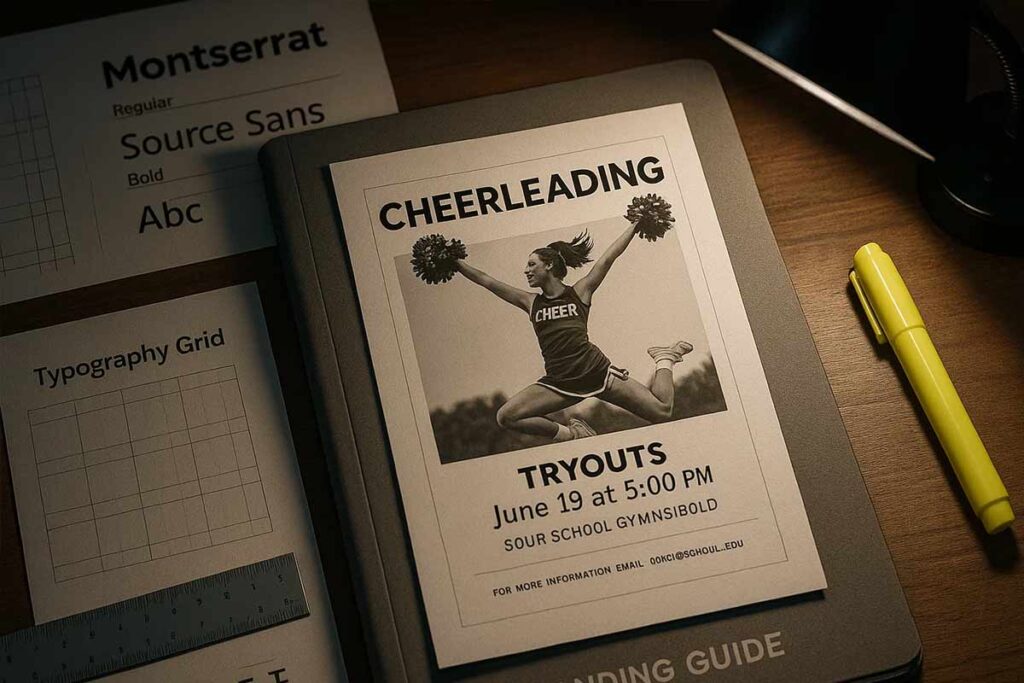
Typography Choices That Communicate Your Training Approach
Typography directly communicates your coaching approach through font personality and structure. Discipline-focused coaches benefit from clean sans-serif fonts like Montserrat or Helvetica that convey organization and precision. These fonts work well for programs emphasizing technique mastery and competitive excellence.
Creative-focused coaches should consider script fonts for headers paired with readable body text, suggesting artistic expression while maintaining professionalism. Font weight variations create emphasis patterns that mirror your training priorities. Bold headers for safety protocols reflect safety-first philosophies, while flowing script headers suggest creativity-centered approaches.
Font sizing creates information hierarchy matching your values. Programs emphasizing team unity might use consistent sizing across team member sections, while achievement-focused programs use larger fonts for accomplishments and statistics.
Communicate your unique coaching philosophy with DesignWiz’s customizable cheerleading flyer templates featuring typography options that reflect your training approach.
- Cheerleading Coach Recruitment Opportunity Flyer Template
- Kids Cheerleading Camp Workshop Flyer Template
- Annual Cheerleading Competition Event Flyer Template
Layout Modifications to Emphasize Your Core Values
Layout structure visually communicates coaching priorities through space allocation and element positioning. Safety-first coaches should dedicate prominent header space to certifications and safety records, using structured grid layouts that suggest organized, methodical approaches.
Community-centered coaches benefit from circular or flowing layouts that emphasize team connections and shared experiences rather than individual achievements. These designs use curved elements and interconnected sections reflecting collaborative training methods. Competition-focused programs work well with dynamic angular layouts featuring bold achievement showcases and statistical presentations.
Color blocking and section divisions should reflect your program structure. Coaches emphasizing skill progression use sequential layouts showing development pathways, while those focusing on fun and friendship create collage-style arrangements celebrating group activities. White space allocation communicates your approach – minimal space suggests intensive programs, while generous spacing implies supportive, pressure-free environments.
Image Selection Strategies for Philosophy-Driven Messaging
Image selection powerfully reinforces coaching philosophy through visual storytelling and emotional connection. Discipline-focused coaches should showcase athletes demonstrating proper form, structured practice environments, and achievement moments that highlight technical excellence.
Fun-centered coaches benefit from candid team bonding moments, creative practice activities, and celebration images showing joyful participation over competition pressure. These images communicate that your program values enjoyment and personal growth alongside skill development.
Safety-conscious programs require images showing proper spotting techniques, appropriate equipment usage, and supervised practice environments. Include coach-athlete interaction photos demonstrating your hands-on approach and attention to individual needs.
Achievement-oriented coaches should feature trophy presentations, competition action shots, and before-after skill progression documentation. However, balance competitive imagery with inclusive photos showing various skill levels to attract families seeking both excellence and supportive environments.
Color treatment of images should match your philosophy – high-contrast processing for competitive programs, warm filters for community-focused approaches, or clean, bright editing for safety and professionalism emphasis.
What Typography Choices In Cheerleading Flyer Design Build Credibility With Prospective Families?
Professional typography establishes immediate trust with prospective families by demonstrating organizational competence and attention to detail. Clean, readable fonts like Montserrat or Open Sans for body text convey professionalism, while bold display fonts for headlines create impact without compromising legibility. Consistent font hierarchies guide parents through key information systematically. Avoiding overly decorative or childish fonts maintains serious credibility while strategic use of brand colors in typography reinforces program identity. Proper spacing, alignment, and contrast ensure information accessibility, showing families that the program values clear communication and professional standards in all interactions.
Professional Font Pairings That Signal Program Excellence
Successful cheerleading flyer design relies on strategic font combinations that communicate coaching expertise and program quality. Pair clean sans-serif fonts like Lato or Nunito for headlines with readable body fonts such as Source Sans Pro or Roboto. These combinations create visual hierarchy while maintaining professional appearance that appeals to discerning parents. Avoid mixing more than two font families, as excessive variety undermines credibility.
Display fonts should emphasize program achievements and coach qualifications without appearing flashy. Use consistent weight variations within the same font family to create emphasis on key information like safety records, competition wins, and coaching certifications. Font sizes must remain legible across all marketing materials, with headlines at minimum 24pt and body text at 12pt or larger.
Color integration within typography should reflect team branding while maintaining high contrast ratios for accessibility. Professional programs use navy, burgundy, or charcoal text colors rather than bright or neon options that appear amateur.
Hierarchy Strategies for Guiding Parent Decision-Making
Effective visual hierarchy directs parental attention through strategic information flow, starting with program credibility markers and moving toward action items. Position coach credentials and safety certifications prominently using larger font sizes and strategic placement. Create clear information pathways using size, weight, and color variations that guide readers from program benefits to enrollment details.
Structure content using the inverted pyramid approach, placing most important information first. Use consistent heading levels with H1 for program names, H2 for major sections like “Coach Qualifications” or “Safety Standards,” and H3 for specific details. This systematic approach helps busy parents quickly locate relevant information.
Implement visual breaks through strategic white space and font styling. Bold key statistics like “15 years coaching experience” or “Zero injuries in 5 years” to create scannable content. Use bullet points with consistent formatting for achievements, requirements, and program benefits, making information digestible for time-constrained families evaluating multiple programs.
Avoiding Typography Mistakes That Undermine Coaching Authority
Common typography errors can instantly damage program credibility with prospective families. Never use comic fonts, script fonts for body text, or excessive decorative elements that suggest unprofessionalism. Avoid all caps for large blocks of text, which appears aggressive and difficult to read. Mixing too many font weights or colors creates visual chaos that undermines organized program image.
Inconsistent spacing between elements signals poor attention to detail, which parents interpret as potential coaching carelessness. Maintain uniform margins, consistent line spacing, and aligned text blocks throughout all materials. Poor contrast between text and background colors reduces readability and accessibility, potentially excluding families with visual challenges.
Size inconsistencies across materials damage brand recognition and professional appearance. Establish clear size standards for different information types and apply them consistently across all flyers, emails, and promotional materials. Text too small for comfortable reading suggests the program doesn’t prioritize clear communication with families.
Overuse of emphasis techniques like bold, italic, and underlining creates visual noise that dilutes important messages.
How Does Strategic Cheerleading Flyer Design Placement Maximize Visibility For Recruitment?
Strategic cheerleading flyer design placement amplifies recruitment impact by positioning promotional materials where target families naturally gather and make activity decisions. High-traffic school corridors, sports complexes, and youth activity centers provide maximum exposure during peak decision periods. Digital placement through social media platforms and school websites extends reach beyond physical limitations. Timing placement with registration seasons, back-to-school periods, and competitive seasons captures families when they’re actively seeking programs. Multi-channel distribution combining print and digital formats ensures comprehensive market coverage while tracking placement effectiveness helps optimize future recruitment campaigns and budget allocation.
Prime Physical Locations for Maximum Family Engagement
School bulletin boards, gymnastics facilities, and dance studios represent prime real estate for cheerleading flyer design visibility. These locations attract parents already invested in their children’s athletic development. Position flyers near registration desks at sports complexes where families complete enrollment paperwork. Community centers hosting youth programs offer concentrated family traffic during evening and weekend hours.
Athletic supply stores provide targeted exposure to sports-minded families actively seeking equipment and programs. Pediatric offices reach health-conscious parents during routine visits when they have time to review program information. Recreation department facilities capture families exploring multiple activity options.
Consider eye-level placement at adult height for parent viewing while ensuring colorful designs catch children’s attention. High-contrast cheerleading flyer design elements improve visibility in crowded bulletin board environments. Weather-resistant materials ensure outdoor postings maintain professional appearance throughout recruitment periods.
Digital Distribution Channels That Amplify Recruitment Reach
Social media platforms extend cheerleading flyer design reach beyond geographical boundaries through targeted demographic advertising. Facebook groups focused on local parenting and youth activities provide concentrated audience engagement. Instagram Stories allow animated flyer previews with direct registration links, creating seamless conversion paths from interest to enrollment.
School district websites and newsletters reach families already engaged in educational communications. Parent-teacher organization email lists deliver recruitment materials directly to involved families during peak communication periods.
Youth sports league websites attract families comparing multiple activity options. Community event calendars on municipal websites provide ongoing visibility throughout recruitment seasons. Email signature integration allows coaches and staff to share recruitment materials through routine communications.
QR codes on printed materials bridge physical and digital distribution, enabling immediate access to registration information. Online community forums and neighborhood apps like Nextdoor reach local families, while exploring cheerleading partnership opportunities with local businesses can expand community visibility..
Seasonal Timing Strategies for Peak Enrollment Periods
Back-to-school timing captures families evaluating fall activity options during late July through August. This period generates maximum search volume for youth programs as parents plan schedules and budgets. Position recruitment materials 4-6 weeks before program start dates to allow family decision-making time.
Spring registration periods for fall programs require early visibility during March through May when families plan upcoming year activities. Competition season showcases during winter months demonstrate program quality to prospective families considering enrollment for following seasons.
Holiday break periods offer extended family discussion time about activity commitments. Parents research options during December vacation weeks when schedules allow program comparison. New Year resolution timing aligns with fitness and activity goal-setting discussions.
Summer camp promotion requires early spring visibility as families book vacation and activity schedules. Competition with multiple camp options demands strong differentiation through achievement showcases and safety credentials.
Track enrollment patterns from previous years to identify specific peak interest periods for your geographic market. Weather considerations affect outdoor program interest, requiring flexible timing adjustments based on seasonal conditions.
Monitor competitor recruitment timing to identify market gaps where strategic placement faces reduced competition. Coordinate placement campaigns with school district communication schedules to maximize family attention during relevant periods.
Maximize your recruitment reach with DesignWiz’s versatile cheerleading flyer templates optimized for both print and digital distribution across multiple channels.
- School Cheerleader Try Outs Announcement Flyer Template
- Cheerleading Coach Recruitment Opportunity Flyer Template
- Cheerleading Tryouts Announcement Flyer Template
What Visual Hierarchy Principles Make Cheerleading Flyer Designs More Compelling For Parents?
Effective visual hierarchy in cheerleading flyer design captures parental attention through strategic placement of safety credentials, coaching qualifications, and student achievements at the top of layouts. Parents respond to clear program benefits, structured pricing information, and prominent contact details positioned for quick scanning. Strong visual flow guides eyes from compelling headlines about team success to specific outcomes like competition wins and skill development milestones, while high-contrast color schemes and organized content blocks help parents quickly assess program value and coaching effectiveness.
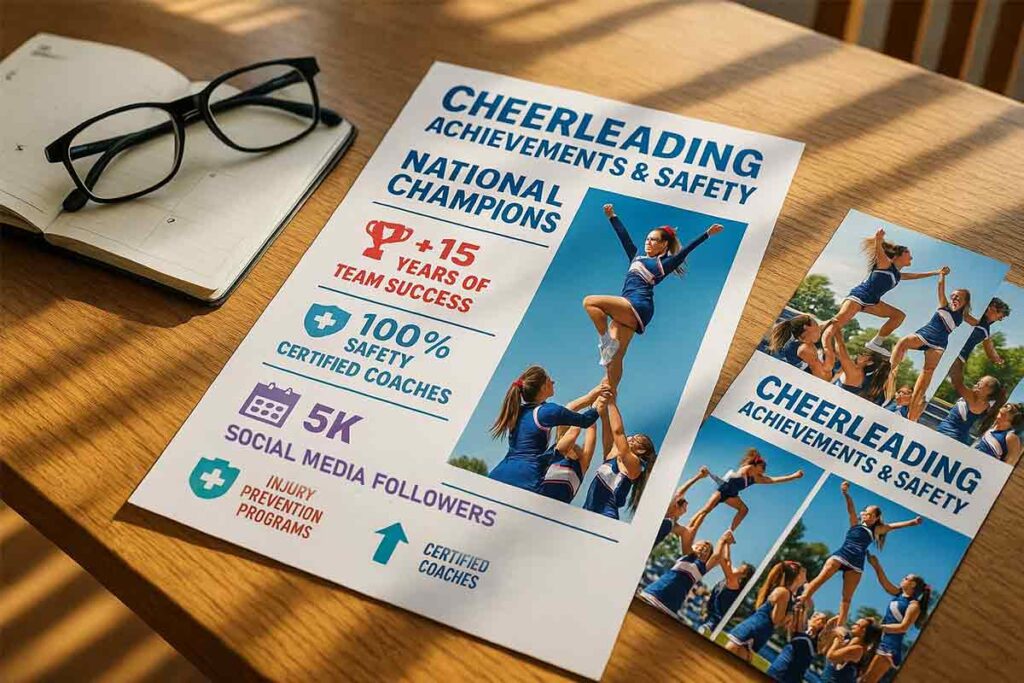
Strategic Placement of Safety Certifications and Coaching Credentials
Position safety certifications and coaching credentials prominently in the upper third of cheerleading flyer designs to immediately address parents’ primary concerns. Use visual weight through larger fonts, distinctive badges, or bordered sections to highlight USASF certifications, first aid training, and years of coaching experience. Create dedicated credential blocks featuring professional headshots paired with qualification lists, making expertise immediately visible rather than buried in body text.
Strategic placement includes header positioning for safety statistics like injury-free records and structured coaching methodologies. Use contrasting colors to make credentials stand out against background elements, ensuring these trust-building elements capture attention within the first three seconds of viewing. Professional typography and clean layouts for credential sections demonstrate organizational competence, showing parents the program values both safety and clear communication standards throughout their operations.
Emphasizing Student Achievement Outcomes Through Visual Weight
Apply visual hierarchy principles to make student achievement outcomes the focal point through size, color, and positioning strategies. Use larger fonts and bold typography for competition wins, scholarship statistics, and skill progression data, creating immediate impact for results-focused parents evaluating program effectiveness. Position achievement galleries and award displays prominently, using grid layouts that showcase trophy collections and medal displays with high-quality photography.
Create visual contrast through color blocks or bordered sections that separate achievement content from general program information. Use infographic elements to display statistics like college placement rates and team GPAs, making data easily scannable. Strategic white space around achievement sections draws attention while preventing visual clutter. Size achievement headlines larger than standard text, and use action-oriented language like “Championship Winners” or “College-Bound Athletes” to create compelling success narratives that demonstrate coaching effectiveness and student development outcomes.
Creating Parent-Focused Information Flow Patterns
Design information flow patterns that match parental decision-making processes, starting with safety and credentials, moving to student outcomes, then program details and pricing. Use Z-pattern layouts for English-reading audiences, positioning most critical information at top-left and bottom-right corners where eyes naturally rest. Create clear visual pathways through strategic placement of headers, bullet points, and call-to-action elements that guide parents through key decision factors systematically.
Implement progressive disclosure techniques where basic program benefits appear first, followed by detailed information for interested parents. Use consistent spacing and alignment to create organized appearance that reflects program professionalism. Position contact information and enrollment deadlines prominently at the bottom, making next steps immediately clear after parents review program benefits.
Color-code different information types – safety in blue, achievements in gold, program details in neutral tones – creating intuitive navigation through flyer content. Use directional elements like arrows or numbered sections to reinforce reading flow, ensuring parents encounter information in logical sequence that builds confidence and moves toward enrollment decisions. Strategic placement of testimonials and success stories throughout the layout provides social proof at key decision points.
Apply proven visual hierarchy principles with DesignWiz’s expertly designed cheerleading templates that guide parent attention through safety credentials, achievements, and program benefits.
- Annual Cheer Banquet Invitation Flyer Template
- Annual Cheerleading Competition Event Flyer Template
- Youth Cheerleading Camp Event Flyer Template
People Also Ask: Flyer Creation And Visual Design Mastery Implementation Questions
- What makes cheerleading flyer design effective for program marketing?
Effective cheerleading flyer design combines clear program benefits, professional imagery, coach credentials, and student success stories. Focus on outcomes like skill development, safety records, and college opportunities to differentiate your program. - How much should program directors spend on cheerleading flyer design?
Budget $200-500 for professional design services or $20-50 monthly for premium design software subscriptions. Quality design investment pays dividends through improved enrollment and program perception among prospective families. - What color psychology works best in cheerleading flyer design?
Use energetic colors like red, orange, and blue to convey excitement and trust. Incorporate your team colors for brand recognition while ensuring readability. Avoid overwhelming color combinations that distract from key program information. - How often should program directors update their flyer designs?
Refresh designs annually or when major program changes occur. Update achievement statistics, coach credentials, and student testimonials regularly. Seasonal variations for different programs keep materials current and engaging for repeat audiences. - What size works best for cheerleading program flyers?
Standard 8.5×11 inches for handouts, 11×17 for posters, and square formats for social media. Consider your distribution method and viewing distance when selecting dimensions for maximum impact and readability. - Can free templates work for professional cheerleading flyer design?
Free templates can be starting points but require significant customization to reflect program quality. Invest in premium templates or custom design to properly showcase coaching expertise and differentiate from competitor programs.
FAQs: Flyer Creation And Visual Design Mastery Implementation
- What software should program directors use for professional cheerleading flyer design?
Flyer maker like DesignWiz offers easy templates and customization, while Adobe InDesign provides advanced design control. Both help create branded, professional materials. - How can I highlight safety achievements in my cheerleading flyer design?
Show safety certifications, injury-free records, and instructor credentials with icons, badges, or dedicated sections to build parent trust. - What student outcome metrics should appear on recruitment flyers?
Feature scholarships, college placements, wins, and skill progress with infographics or stats to prove program effectiveness. - How do I create brand consistency across all cheerleading program flyers?
Use a style guide for colors, fonts, logo placement, and tone. Keep layouts, filters, and spacing consistent to reinforce brand recognition. - What call-to-action elements work best on cheerleading tryout flyers?
Include deadlines, contact info, and steps. Use action phrases, QR codes for registration, and highlight limited spots for urgency. - How can flyer design communicate coaching qualifications effectively?
Show coach credentials, headshots, and years of experience. Add testimonials to reinforce expertise and value. - What image selection best represents program quality in flyers?
Use authentic action shots, celebrations, and facility photos. Avoid generic stock images to showcase your real environment and results. - How do fundraising flyers differ from recruitment flyer design?
Fundraising flyers focus on goals, athlete stories, donor benefits, and show how funds improve resources and experiences. - What seasonal considerations affect cheerleading flyer design timing?
Release tryout flyers in spring, camp promos in early spring, and competition flyers in fall, matching school calendars and seasonal energy. - How can digital vs print flyer designs be optimized differently?
Digital flyers can use links and videos; print needs larger fonts and simpler layouts. Include QR codes in print and optimize digital for social sharing.
Conclusion: Flyer Creation And Visual Design Mastery Success Framework
Effective cheerleading flyer design transforms program marketing into a credibility-driven recruitment strategy by showcasing authentic achievements and coaching expertise, with programs focused on maximizing cheerleading recruitment effectiveness understanding that design quality directly impacts enrollment success. Using high-quality templates customized with real program outcomes, such as competition wins, skill progression visuals, and scholarship placements, builds trust and sets a program apart from competitors. Strategic design choices in color schemes, typography, and visual hierarchy ensure that safety credentials, coach qualifications, and success metrics are presented prominently to influence parent decision-making.
To stand out, cheerleading recruitment and event flyers must go beyond generic imagery, incorporating genuine athlete testimonials, trophy displays, and measurable results that reflect the program’s true strengths. Consistent branding across tryout flyers, camp promotions, and seasonal events reinforces program identity, while targeted distribution, both physical and digital, ensures maximum visibility during peak enrollment periods. This approach not only boosts sign-ups but also strengthens long-term community reputation.
Reference
- Cheerleading Injuries: Epidemiology and Recommendations for Prevention. American Academy of Pediatrics.
- The Role of Coach Education in Coaching Philosophy Development and Implementation. Academic sports research publication.
- Scholarships Program Statistics. National Collegiate Athletic Association (NCAA).
- Effective Visual Communication for Quantitative Data Presentation. Biotechnology Information – Government medical.
- Benefits of Consistent Branding – Texas A&M University Marketing & Communications.
